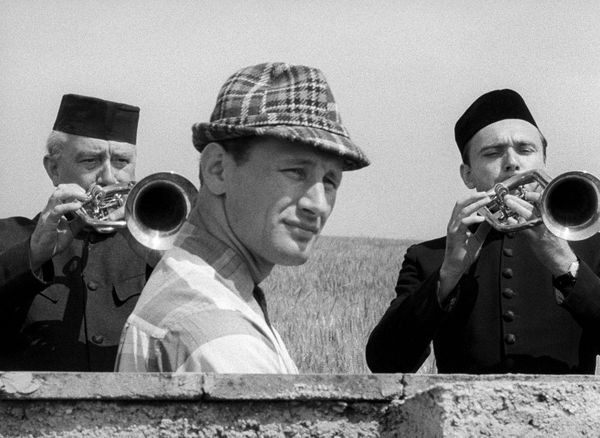 |
| Intimate Lighting is a complex mixture of absurdity and regrets. Photo: Courtesy of Karlovy Vary International Film Festival |
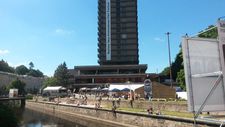 |
| Crowds gather in the shadow of Hotel Thermal Photo: Amber Wilkinson |
Crowds gather in the shadow of the Functionalist/Brutalist Hotel Thermal, its tower dominating the skyline, to hang out by the River Tepla until late at night, sharing gossip and views about the day's films and stars over a beer or, this year, even a vodka-filled coconut - all somewhat more tasty, though doubtless worse for your liver, than the salty, hot thermal waters available at drinking fountains in the town's Colonnade. The Thermal may be the festival hub but venues are scattered across the town - including the Neo-Baroque Municipal Theatre, the intricate interior of which is much more beautiful than its name suggests, and the Husovka theatre, a dark and tightly packed basement, situated at a top of a hill that proves a brutally steep challenge for latecomers.
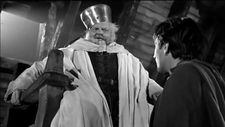 |
| Orson Welles and Keith Baxter in Chimes At Midnight. |
There were plenty of homegrown classics at the festival this year, too, including Czech New Wave gem Intimate Lighting - screened from a newly restored print - which presents a series of lightly comedic, slightly wistful vignettes during a weekend reunion of two old school friends. It's 10 years since these musicians have met and as they come together at the house of one of the men ahead of a concert. Ivan Passer gently scratches at the surface of their lives to reveal a complex mixture of absurdity and regrets, mitigating melancholy with mirth. Many of the film's best moments come at the family dining table, with food a recurring theme in Czech cinema, also highlighted by fellow classic The Party And The Guests. Jan Nemec's film has lost little of its potency in the years since it was "banned forever" by Czechoslovak President Antonín Novotný in 1973 - and it's a shame the director, who died at age 79 in March, couldn't have seen the large crowd which filled the Municipal Theatre to view it this week. His film uses food in its early stages to suggest frivolity and companionship at an intimate picnic, later finding sharp contrast in absurdist dishes of what appear to be sausages perched on shells at a banquet where guests can check out any time they like, but they can never leave.
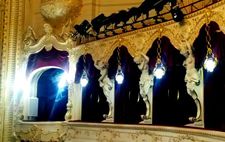 |
| The intricate setting of the Municipal Theatre is perfect for Chimes At Midnight Photo: Amber Wilkinson |
You can't help but wonder what a director like Polák would have done if he'd had colour film and modern CGI at his disposal; after all, there there were a clutch of modern directors looking to the past who opted for the uniformity of black and white for their new work. In I, Olga Hepnarová - about the life and crime of the last Czechoslovak woman to be executed - the monochrome choice bolsters the film's austerity, somehow making the character's emotions seem even more glass-like and impenetrable. While Petr Kazda and Tomás Weinreb's film suffers from an over-reliance on voice-over and dialogue towards its latter stages, its aesthetic and framing remain strong throughout.
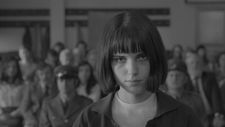 |
| Michalina Olszanska in I, Olga Hepnarová |
Other notable films at the festival included Slovak drama The Teacher. Jan Hrebejk's film, from a screenplay by Petr Jarchovský, is set in the Czechoslovakia of the Eighties, where the "reluctant terror" of Normalisation held sway. Beginning after an event which is not revealed until much deeper in the film, a school has taken the unusual step of calling a parents' meeting to discuss one of its teachers. Mrs Drazdechová (Zuzana Mauréry, who deservedly took home an acting prize from the festival for her role) appears to be full of sweetness and light but her interest in the occupations of her pupils' parents is unsettling and we soon see her become a force for manipulation, able to conduct a campaign of hidden fear courtesy of her Communist Party standing. The parents' evening has the claustrophobic feel of 12 Angry Men as the parents bicker through their fear. Although firmly anchored in a specific time and place, the film is a sharp allegory for the way in which power corrupts.
Documentaries of note included the immersive and observational Normal Autistic Film and Under The Sun - both of which take a distinctly psychological approach to their subjects. In Normal Autistic Film, Miroslav Janek collaborates with young people on the autistic spectrum to let them talk about their lives and emotions. He particularly celebrates ideas of neurodiversity - these are children who are continually thinking outside the box, even if that can sometimes mean they destroy the box in the process. "To me society is disabled," says one, and you're likely to agree after watching this.
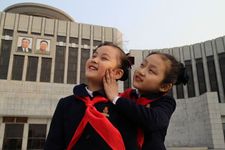 |
| Under The Sun |
Read about the Karlovy Vary non-statutory and gala winners. British cinemagoers will get to sample some of the best of Czech cinema this autumn at London's Made In Prague festival organized by the Czech Centre London. We'll be bringing you details of the line-up when it is announced.





















